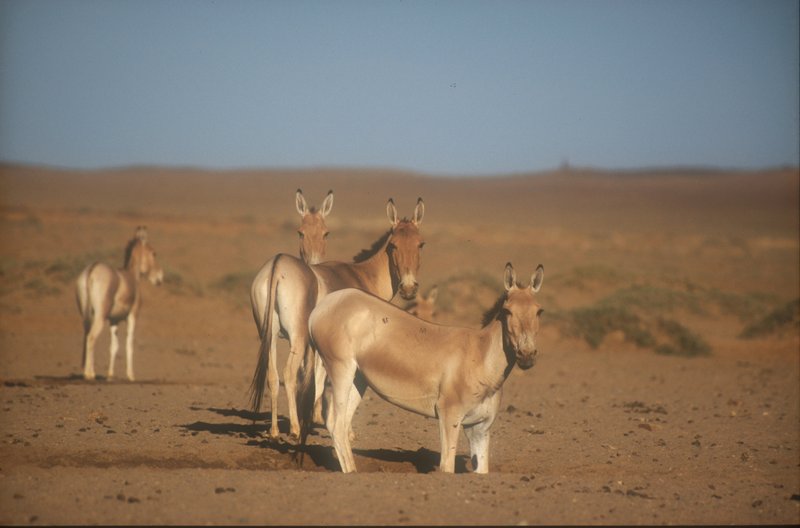|
| 질의: new international encyclopedia | 결과: 52번째/86 | |
Mongolian Wild Ass (Equus hemionus hemionus) - Wiki
| 제목: | Mongolian Wild Ass (Equus hemionus hemionus) - Wiki
| |

| 해상도: 3639x2403
파일크기: 928603 Bytes
촬영일: 2005.08.20 23.00.09
등록시간: 2007:10:18 00:32:41
|
Mongolian Wild Ass
From Wikipedia, the free encyclopedia
[Photo] Mongolian Wild Ass (Equus hemionus hemionus). Photo by Petra Kaczensky. Copyright (C) Petra Kaczensky
Permission is granted to copy, distribute and/or modify this document under the terms of the GNU Free Documentation License, Version 1.2 or any later version published by the Free Software Foundation; with no Invariant Sections, no Front-Cover Texts, and no Back-Cover Texts. A copy of the license is included in the section entitled "GNU Free Documentation License". |
The Mongolian Wild Ass (Equus hemionus hemionus, also called Khulan) is a subspecies of the Onager. It may be synonymous with the Gobi Kulan or Dziggetai subspecies (Equus hemionus luteus). It is found in Mongolia and northern China, and was previously found in Kazakhstan before it became extinct due to hunting.
The Mongolian Wild Ass's distribution range was dramatically reduced during the 1990s. A 1994-1997 survey estimated its population size at 33,000 to 63,000 individuals over a continuous distribution range encompassing all of southern Mongolia. In 2003, a new survey found approximately 20,000 individuals over an area of 177,563 km² in southern Mongolia. The population estimates of the Mongolia population should be treated with caution due to a lack of proven survey protocols. Despite that, the subspecies lost about 50% of its former distribution range in Mongolia in the past 70 years.
The population is declining due to poaching and competition from grazing livestock and the conservation status of the species is evaluated as vulnerable. Since 1953, the Mongolian Wild Ass has been fully protected in Mongolia. The subspecies is also listed at appendix I of the Convention on the International Trade in Endangered Species (CITES) and was added to appendix II of the Convention of Migratory Species in 2002. However, due to human population growth in conjunction with severe winters in the past years, the number of conflicts between herders and Mongolian Wild Ass's appear on the increase.
Poaching for meat appears to be an increasing problem in Mongolia. For some parts of the local population, wild ass and other wildlife meat seems to provide a substitute or even a cheap alternative to meat from domestic animals. In 2005, a national survey based on questionnaires, suggested that as many as 4,500 wild asses, about 20% of the whole population, may be poached each year. Moreover, political changes in the early 1990's allowed urban populations to return to nomadic land use, resulting in a sharp increase in human- and livestock numbers in many rural areas.
Political and socital changes have disrupted traditional land use patterns, weakened law enforcement and also changed attitudes towards the use of natural resources, e.g. making wildlife an “open access” resource. It is expected that the remigration of people and their livestock will result in increased wildlife-human interactions and may well threaten the survival of rare wildlife species in the Gobi Desert.
http://en.wikipedia.org/wiki/Mongolian_Wild_Ass
| The text in this page is based on the copyrighted Wikipedia article shown in above URL. It is used under the GNU Free Documentation License. You may redistribute it, verbatim or modified, providing that you comply with the terms of the GFDL. |
|
댓글 |
|---|
| | 손님 |
|
Scientific Name: Equus hemionus hemionus Pallas, 1775
Common Names: Mongolian Kulan
Synonyms: Equus hemionus luteus Matschie, 1911 |

|

|

|
new international encyclopedia
52/86 |

|

|
^o^
동물그림창고 똑똑전화 누리집
^o^
|
|
|